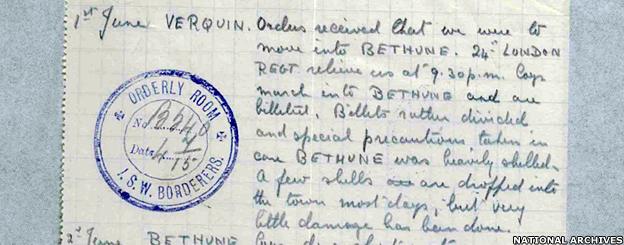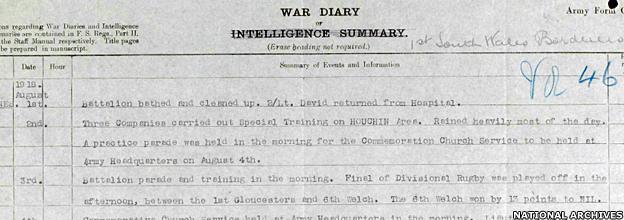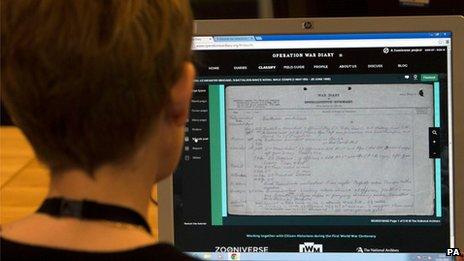WW1 soldier diaries placed online by National Archives
- Published
This year marks the 100th anniversary of the start of World War One
Diaries from British soldiers describing life on the frontline during World War One are being published online by the National Archives.
Events from the outbreak of war in 1914 to the departure of troops from Flanders and France were recorded in official diaries of each military unit.
About 1.5 million diary pages are held by the National Archives and a fifth have been digitised so far.
The project is part of the government's World War One centenary programme.
Each unit in World War One was required to keep a diary of its day-to-day activities.

The First Battalion South Wales Borderers went to France as part of the British Expeditionary Force in 1914
The first batch of 1,944 digitised diaries, external detail the experiences of three cavalry and seven infantry divisions in the initial wave of British army troops deployed in 1914.
Diaries from soldiers in the First Battalion South Wales Borderers portray the anxiety and terror of the opening days of the war in the battles of Marne and the Aisne.
They also reveal accounts of tug of war, rugby matches and farewell dinners to mark the end of the fighting.

In total, more than 1,200 men from the First Battalion South Wales Borderers were killed during the war
A private war diary kept by one of the First Battalion's soldiers, Captain James Paterson, has also been digitised.
Captain Paterson died on 1 November, some six weeks after an entry said the scenes he witnessed were "beyond description".
"Trenches, bits of equipment, clothing (probably blood-stained), ammunition, tools, caps, etc, etc, everywhere. Poor fellows shot dead are lying in all directions. Some of ours," he said.
"Everywhere the same hard, grim, pitiless sign of battle and war. I have had a belly full of it."

The private war diary of Captain James Paterson describes dead bodies "in all directions"
Other entries record the experiences of the 4th Dragoon Guards who fought in the Battle of Mons, the first major action of the war for the British Expeditionary Force in August 1914.
There are also diaries from soldiers of the 5th (Royal Irish) Lancers who saw action continuously between 1914 and 1918 and who included the last British soldier to die in the conflict, Private George Edwin Ellison, who was shot dead on 11 November 1918.
Some 25 volunteers scanned hundreds of boxes of diaries - which had been available for the public to view at the National Archives in Kew since the late 1960s - between January and December last year.
William Spencer, author and military records specialist at the National Archives, said it "creates opportunities for the public, history enthusiasts, family historians and researchers worldwide to explore the official records which may lead to some new discoveries and perspectives on this important period of history".
The National Archives, the Imperial War Museum and online research website Zooniverse are also launching Operation War Diary, a project aiming to encourage volunteers to uncover details from within the diaries.
Luke Smith, from the Imperial War Museum, said information that may not have previously been communicated through letters home or covered in traditional history books may be contained in the diaries.

Volunteers are being encouraged to uncover new details about WW1
The volunteers to the project will be given a segment of a unit war diary and asked to tag key details such as names, places and events.
The data will be used in the National Archives' catalogue descriptions for the diaries, making it easier for people to trace their army ancestors.
Culture Secretary Maria Miller said: "The National Archives' digitised First World War unit diaries will allow us to hear the voices of those that sacrificed their lives and is even more poignant now there are no living veterans who can speak directly about the events of the war."
Harry Patch, the last British survivor of the World War One trenches, died in 2009 aged 111.
The world's last known combat veteran of World War One, Claude Choules, died in Australia aged 110 in 2011.
- Published29 November 2013
- Published24 October 2013
- Published11 October 2012
- Published16 October 2013
- Published5 November 2013
- Published10 November 2013
- Published25 November 2013
- Published8 January 2014